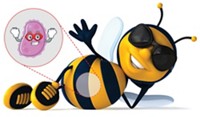Advertisement
Grab your lab coat. Let's get started
Welcome!
Welcome!
Create an account below to get 6 C&EN articles per month, receive newsletters and more - all free.
It seems this is your first time logging in online. Please enter the following information to continue.
As an ACS member you automatically get access to this site. All we need is few more details to create your reading experience.
Not you? Sign in with a different account.
Not you? Sign in with a different account.
ERROR 1
ERROR 1
ERROR 2
ERROR 2
ERROR 2
ERROR 2
ERROR 2
Password and Confirm password must match.
If you have an ACS member number, please enter it here so we can link this account to your membership. (optional)
ERROR 2
ACS values your privacy. By submitting your information, you are gaining access to C&EN and subscribing to our weekly newsletter. We use the information you provide to make your reading experience better, and we will never sell your data to third party members.
Lab Safety
Newscripts
Flying pink objects and an autoclave in your kitchen
by Megha Satyanarayana
March 2, 2019
| A version of this story appeared in
Volume 97, Issue 9
Disco squirrel glows pink

It’s the stuff of folk legends—a hot-pink flying squirrel, soaring around the forests of northern Wisconsin.
Except that it’s real, says Jonathan Martin, a forestry professor at Northland College. When he saw one for the first time, he says, “My jaw dropped.”
Martin had gone into the woods to search for frogs that fluoresce. A recent paper had described them in South America, and he wondered if their northern cousins did the same. As he searched with an ultraviolet light, a flying squirrel rustled overhead, landing on a bird feeder. He swung the light around, and there it was, wildly, fluorescently pink. “It’s hard to describe how bright and intense it can be,” he says of the coloring.
He snapped a few blurry pictures, texted some colleagues, got a couple of incredulous “Come on, dude” responses. But one by one, as they came out with their own UV lights, the skeptics saw the squirrels for themselves and were sold.
Martin wondered if these squirrels were the only ones. He challenged Allie Kohler, then a senior at Northland College, to find out (J. Mammal. 2019, DOI: 10.1093/jmammal/gyy177).
Kohler studied wild flying squirrels. She studied specimens at museums in Minnesota and Chicago. More than 100 flying squirrels later, she tells the Newscripts gang, “Every single one I saw fluoresced bright pink in one intensity or another.”
So what causes it? Sharon Anthony, a chemistry professor at Northland, says they are knee deep in fluorescence spectroscopy, trying to figure it out. Martin says the compound seems to be in the hair of the squirrel and not something secreted.
Kohler says whatever they find about what causes the coloring, it could have medicinal uses, perhaps in imaging.
But a more basic question that the research team wants to answer is what the pink coloring is for. Do the flying squirrels see each other as pink? Their eyes allow them to see UV light. Is it camouflage from predators who also live in treetops?
“At this point, Martin says, “it’s up in the air.”
Instant Pot setting: Sterilize

Scientists who do fieldwork in remote corners of the globe might carry something unexpected in their checked baggage—a pressure cooker. But it’s not to make dinner, says Patrick Videau, a biology professor at Southern Oregon University. It’s to sterilize instrumentation and growth medium for experiments.
It’s a pretty common practice, he says, so he was surprised to see that no one had ever published anything about which pressure cookers work best. He and his colleagues decided to do a scientific study.
They lined up the candidates: the Cosori, the Gourmia, the GoWISE, and the Instant Pot. They whipped up liquid media and agar media, and then they tested whether spores from the heat-tolerant bacteria Geobacillus would grow. The winner, says Videau, was the Instant Pot (PLOS One2018, DOI: 10.1371/journal.pone.0208769).
Advertisement
“The Instant Pot was nice because it was a lot more tunable. It could run longer. The others, not so much,” he says. Plus, “The Instant Pot inactivated the spores.”
He sees this tool being used for laboratory work in low-resource countries, in schools, or anywhere the science needs to be sterile and the possibility of buying or transporting an autoclave is nil.
“The idea was just to potentially make sterilization available. If we can show that this is OK and that it’s scientifically functional, you can put an Instant Pot in a bag and ship it to Palmyra,” he says, referring to the Palmyra Atoll, one of those remote places where his colleagues do their work.
Megha Satyanarayana wrote this week’s column. Please send comments and suggestions to newscripts@acs.org.





Join the conversation
Contact the reporter
Submit a Letter to the Editor for publication
Engage with us on Twitter